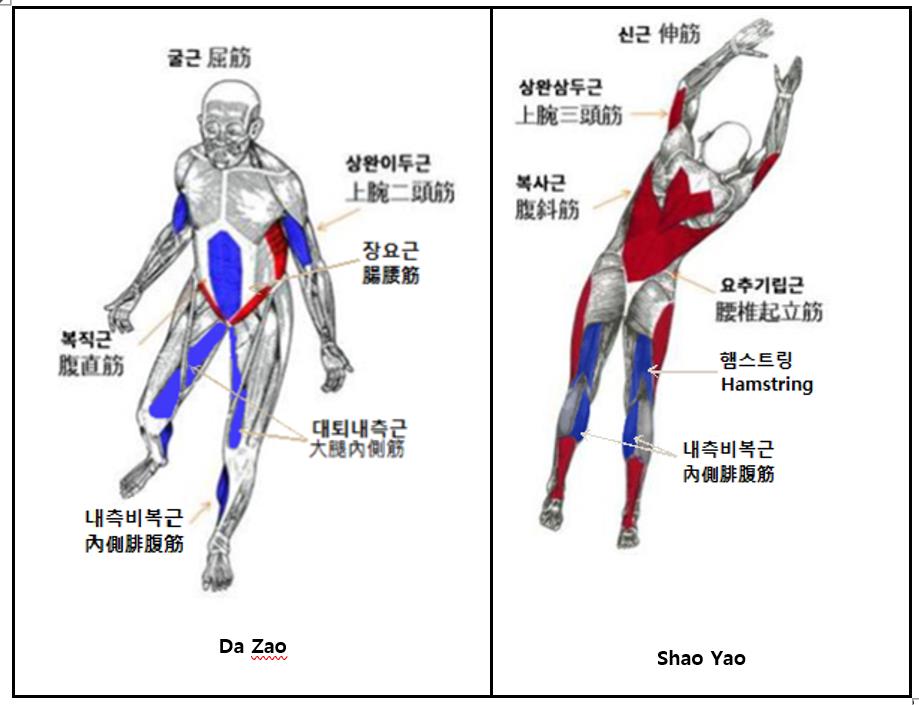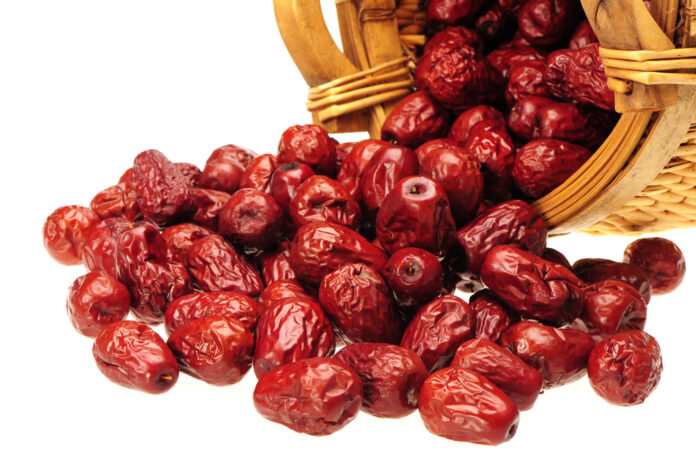Finding A Guiding Herb Makes Easier to Find the Most Efficient Formula ⑤ Da Zao(大棗)
By Hyunchang Cho, L.Ac., Ph.D (c0454445@gmail.com)
|
Da Zao Symptom Indicator Score+ Frequency of Use+++ Main symptoms: ① Hypertonicity (extreme tension) of Da Zao muscles (mostly extensor and postural muscles). ② Pulling, cramping, twisting, and Stiffness due to Hypertonicity of brachial triceps, rhomboids, lumbar erectus muscles, oblique muscles, rectus abdominis (below the navel), inguinal ligament, iliotibial tract, Achilles tendon, plantar fascia, and such are common. Muscle Test (Palpatory Diagnosis): ③ Stiffness and tenderness of triceps and rhomboid muscles. If Da Zao muscle signs are positive, you may or may not choose to use Da Zao.You can still use Da Zao with negative Da Zao muscle signs. In short, Da Zao muscle signs are not binding signs, and you can choose to ignore them. |

- Pharmacological Hypothesis of Da Zao and Shao Yao ▶Blue muscles indicate Shao Yao muscles and red muscles indicate Da Zao muscles.
- Clinical Signs of Da Zao: We can consider Shao Yao for musculoskeletal pain due to muscle hypertonicity. Suppose the patient says “I get cramps easily, or have pulling sensations, stiffness, muscle twisting, dystonia, contraction and such.”. In that case, we can take such words as expressions of muscle hypertonicity and consider Da Zao or Shao Yao. We can also consider Da Zao or Shao Yao in other disorders if such muscle hypertonicity exists.
|
* Hypertonicity of Da Zao muscles such as white tendons of extensor and postural muscles. * Pulling, cramping, twisting, and Stiffness due to Hypertonicity of brachial triceps, rhomboids, lumbar erectus muscles, oblique muscles, rectus abdominis (below the navel), inguinal ligament, iliotibial tract, Achilles tendon, plantar fascia, and such. |
In clinical practice, the Hypertonicity of Da Zao muscles is not limited to the list of Da Zao muscles mentioned above. Rather, it can be present in virtually all muscles. But it does appear more often in Da Zao muscles.
Therefore, Hypertonicity of Da Zao muscles is most commonly observed in brachial triceps, rhomboids, lumbar erectus muscles, oblique muscles, rectus abdominis (below the navel), inguinal ligament, iliotibial tract, Achilles tendon, plantar fascia, and such. Patients will complain of muscle pains in their nape, shoulder, back, flank, lower back, lower stomach, heel, or sole, all of which are mainly located in the posterior and lateral sides of the body. As such, overstrain of Da Zao muscles can lead to pains in the neck, shoulder, back, flank, lower stomach, inguinal ligament, leg, heel, sole, etc.
|
Clinical Expressions * Patients will complain of muscle pains caused by muscle hypertonicity in the posterior and lateral sides of the body, manifested as cramping, pulling, Stiffness, or dystonia. * Neck stiffness is common. The upper back and shoulders will feel sore, and a limited range of shoulder movement will be seen. * Lower back pain. Holding the same position for a long time, such as lying down, sitting, or standing, will aggravate the pain. Lower back and legs will feel sore. * Flank pain. Due to pulled muscles in the area, patients will be unable to stretch their sides. * Lower abdominal pain and menstrual cramps of unknown causes. * Muscle pain of the inguinal ligament, or sometimes genital(testicular) pain. * Growing pains in children/adolescents causing nocturnal leg pains. Sports players who suffer from cramps after consecutive games.* Frequent muscle cramps of the legs. A stretch or overuse will easily lead to cramps. * Walking or standing for long periods will cause heel/sole pain. Taking the first step in the morning will be painful. This is because heels/soles are mostly white tendons, which means they are Da Zao muscles. In clinical practice, such pains usually manifest as heel/sole pain due to Achilles tendonitis. |

































